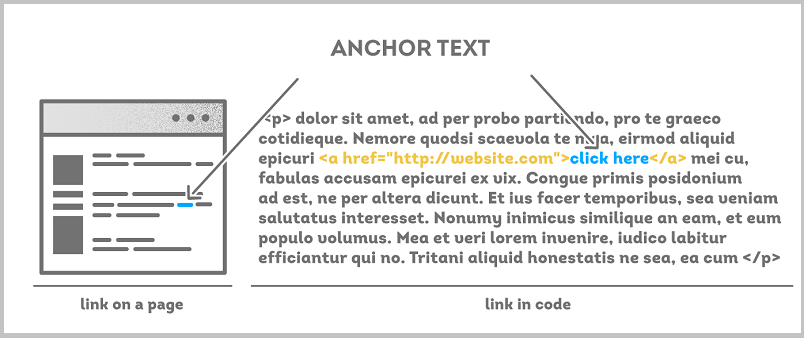by Venchito Tampon Jr | Last Updated on June 28, 2023
What is an anchor text?
An anchor text is a clickable text that appears as a hyperlink and links to a web page. It tells search engines what the linked page is about, and its usage is an important factor in SEO. Anchor texts should be descriptive and relevant to the linked page’s content to help users and search engines understand the page better.
This is an anchor text guide for beginners and advanced SEO and link-building practitioners.
What are the types of anchor texts?
The types of anchor texts are exact-match, partial-match, branded, naked link, generic, and images.
SEO-friendly anchor text is that which clearly describes the linked-to page’s content and context, and the surrounding content should provide additional context. It is recommended to use various anchor text types to appear natural to both users and search engines. Remember that excessively using exact-match or other manipulative types can lead to penalties by search engines.
To simplify things, let’s say I want to rank for the term, “link building” and I’m publishing a post for another link building blog with a link to my web page.
If I’d use these types of anchor text, here’s what the link with each type of anchor text looks like.
Exact match anchors – the anchor text is the target keyword you’re trying to rank for.
I’ve shared at SharpRocket a post about link building that includes all actionable tips you need to get quality backlinks for your website.
Partial match anchors – the anchor text contains the target keyword or keyphrase you’re trying to rank for.
I’ve shared at SharpRocket a post about actionable link building tips you need to get quality backlinks for your website.
Branded anchor text – the anchor text is the name of the brand.
I’ve shared at SharpRocket a post about link building that includes all actionable tips you need to get quality backlinks for your website.
Naked URLs anchors – the anchor text is not a word or phrase but the URL of the page or domain itself.
I’ve shared at SharpRocket a post about actionable link building tips. See it here: URL
Descriptive anchors – the anchor text is a description of what the page or URL is all about, it may or may not include the target keyword.
This post at SharpRocket explains what link building is all about and 101 link building tips that includes the exact step by step processes to apply each of those tips.
Generic anchors – the anchor text is a generic phrase that does not include the target keyword.
I’ve shared at SharpRocket a post about link building that includes all actionable tips you need to get quality backlinks for your website. If you want to check it out, click here.
LSI anchors – the anchor text is a synonym or related word or phrase of the target keyword you’re trying to rank for.
I’ve shared at SharpRocket a post about off-page SEO that includes all actionable tips you need to get quality backlinks for your website.
Image anchors – the anchor text is the alt text of the image.
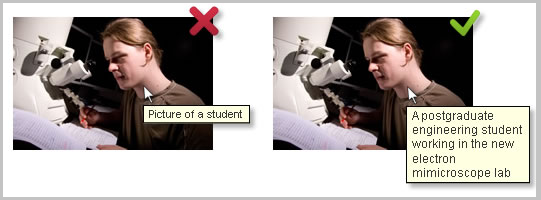
Google Penguin in 2012 and 2023 Forward
Before the Google Penguin update, websites could build massive article directories and guest post links with ~100% exact match anchor texts. This was not a problem for SEOs as they can automate everything, from prospecting link opportunities to putting these links into their desired pages, not considering the relevance between linking pages.
Private blog networks weren’t a big option for link builders then, too, since the usual massive spammy link building tactics were already enough to get website ranking results.
But then Google Penguin came in 2012, which affected websites in different industries. As you can see in the image below, it shows a few statistics of niche websites that were hit back then.
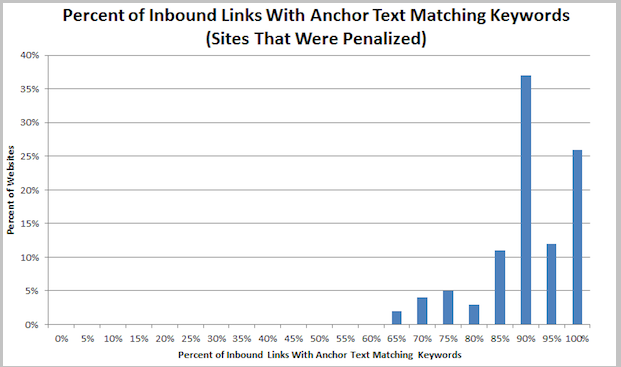
Anchor Text Usage
Anchor text usage on all inbound links is one factor Google considers in determining if a page should be penalized and demoted in its organic rankings.
Aggressive anchor text or too much exact match anchor text on all inbound links for a certain page isn’t a normal activity to think about. Websites with all backlinks with more than 50% exact match anchor texts, “payday loans” for example, are questionable to be natural in their backlinking method.
Source Website
Google’s Gary Ilyes has been tweeted/asked questions on Penguin 4.0 since its launch last September 23, 2016. One point he made is how Google Penguin targets a specific page. He clarified that it’s not just about the link, but rather the “source site” where the link comes from is what they also consider.
Questionable or penalized websites have much more risks to give to you when acquiring links.
To ensure you’re only building high-quality sites, check out the site’s organic traffic data if the linking site has a history of organic drop. This organic drop is a possible sign of Google penalties.
SEMRush can aid you with this task, so have someone check the site’s estimated organic data.
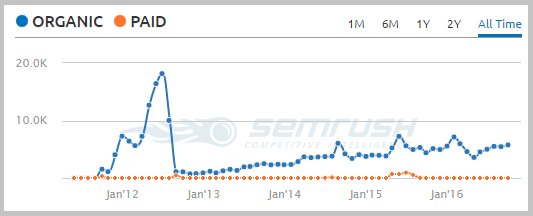
More Granular
The granular attack of Penguin on pages that need to be demoted in its rankings isn’t any newer to the search engine optimization community (in Penguin 2.0, it seemed to be on page-level and keyword-level concerns already). The only thing that becomes clearer here is the word “more”, which we should all consider as we work on the website’s link acquisition campaigns.
It’s just that Google considers page-to-page or a few website parts as its consideration for penalties. In that sense, you shouldn’t be confident enough to think that the spammy link building tactics you are doing right now won’t hurt your website’s health in the future.
More Google Penguin 4.0 Resources:
9 Anchor Text Optimization Best Practices
1. Avoid Acquiring Backlinks With Too Many Exact Match Anchors
I’ve worked with a lot of SEO agencies and digital marketing agencies all over the world, catering to 100+ clients throughout my SEO corporate experience, and there’s one thing people are still confused about:
Are exact match anchors good for my rankings?
When you answer them “YES” right away, they’ll defend you with their “NO”s and just tell you to use generic anchor texts, like click here and go to this site, because they think this is the best anchor text strategy.
Wrong.
Exact match anchor texts aren’t bad at all.
Ryan Stewart had an interesting short case study of how he could rank for Miami SEO after he published a guest post on Ahrefs with the exact match anchor text: “Miami SEO”.
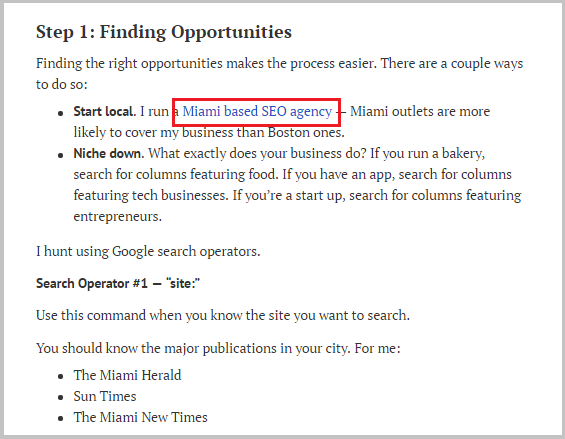
You don’t have to consider the anchor text distribution percentage in your backlink profile – say 3 or 5 percent.
You can test for yourself building one or two backlinks to your page with an exact match anchor text.
Don’t be afraid. Your site won’t get penalized with 1 or 2 backlinks. After all, if you have hundreds or thousands of backlinks, those 2 exact match anchor text links account for less than 1%.
Check how the site will react to those two backlinks and see what movements your page will take you (e.g. from position 40 to position 12). You’ll then also see how tight the competition is for the target keyword you’re trying to rank for.
2. Focus on Various Link Types
It’s so easy to be stuck with the idea of anchor text ratios. While running other SEO activities like technical audit, content creation, and outreach, you still have to think about establishing a natural backlink profile.
Instead of getting a headache with that issue, focus on the link type. After all, why must you create a list of anchor texts with exact/estimated percentages if you’re aiming for a natural link profile?
That itself is unnatural.
A natural link profile is composed of backlinks with different link types.
Here are some examples of different link types.
1. Community-based link
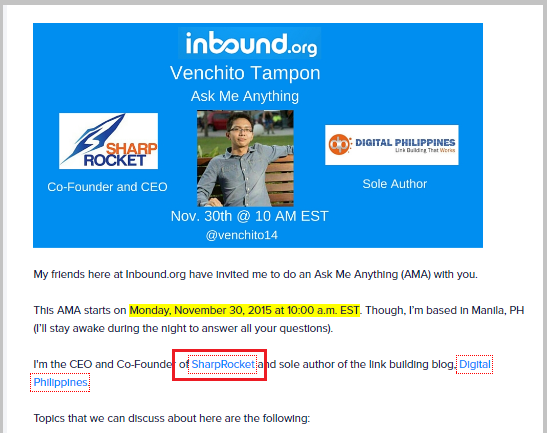
2. Referential link
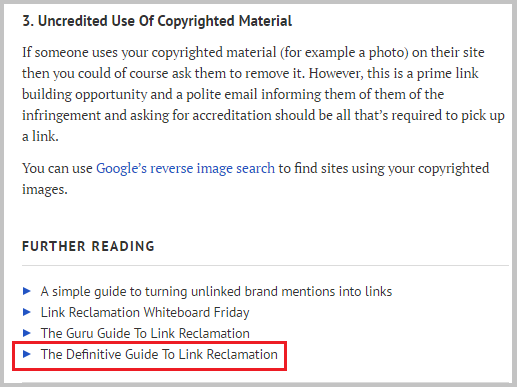
3. Blog comment link
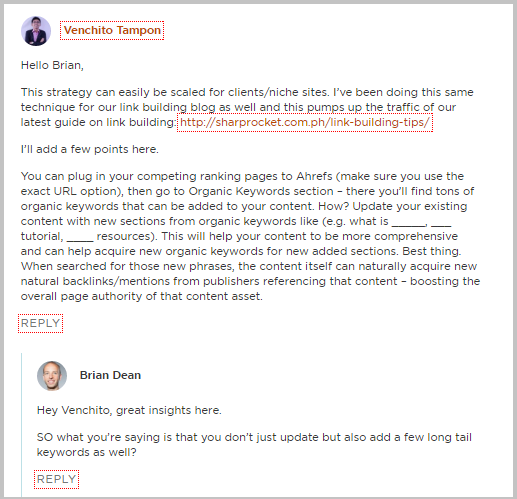
Don’t focus too much on anchor text variations, but ensure that you get various backlink types for your website.
Note: There’s one exception here, I’ve seen websites that focus only on contextual (both earned and built) and resource types of links, and they didn’t acquire directory or citation links but are still dominating SERPs. But if you’re into local SEO, combining those contextual and resource links with local-centric profiles/association/directory links is a must.
But if your site gets directory and citation links with a few to zero contextual backlinks, that looks unnatural.
3. Optimize Clicks Using Descriptive Anchor Texts
If you are still thinking about what anchor text strategy to use for your link building campaign, let me give you one simple tip.
If you are reaching out to bloggers in your industry (assuming it is a linker outreach approach), let them choose anchor texts.
They wouldn’t tell you what anchor texts they chose. They’d only give you a heads-up if they have linked to your page, and you’ll see the anchor texts yourself.
Most of the time, backlinks built using the linker outreach method are in descriptive anchor texts. The advantage of that anchor text is that it encourages user clicks.
While links can help increase rankings, their other purpose is to drive referral traffic.
Letting bloggers choose how and in what section of the linking pages they’ll add anchor texts with backlinks to your webpage affects the number of visitors those referring sites will drive back to your site. Backlinks placed on a higher position of the content have a high chance of more clicks.

One good example is the number of conversions (email subs) from my guest post on GotchSEO. That post itself drove 100+ impressions with 60+ converted email subscribers. That backlink is aimed to be clicked, given that it was placed under the bonuses section.
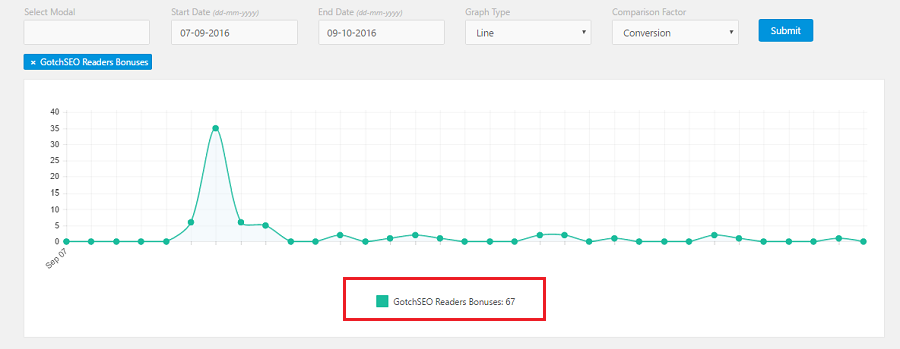
In cases where you have control over anchor text usage, i.e. content distribution on other blogs, it’s imperative to understand LSI and Co-occurrence as part of your overall anchor text strategy.
4. Understand and Use Co-Occurences
Co-occurrence s the frequency and proximity of similar keywords across one context in content. These are topically relevant keywords but not exactly the same as your ranking keyword.
Instead of frequently using your ranking keyword as your anchor text to be an exact match, what you can do is place your target keyword near descriptive anchor texts.
One good example of this is co-occurrences within links to Kaiserthesage. Here are a few examples:
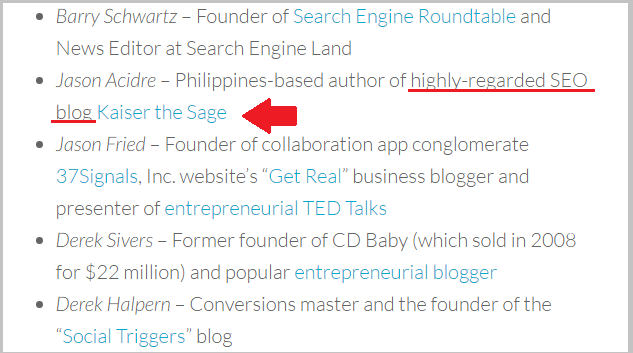
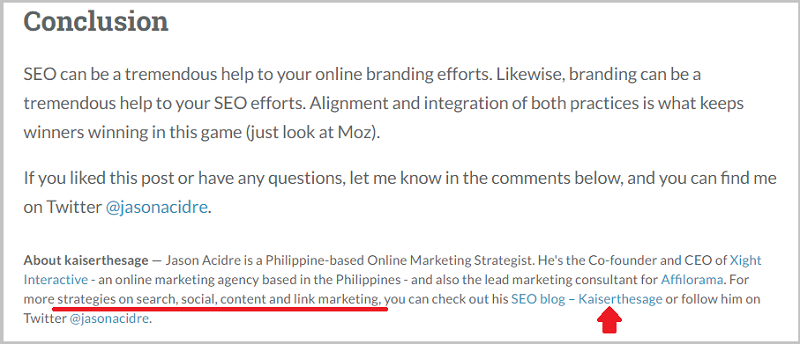

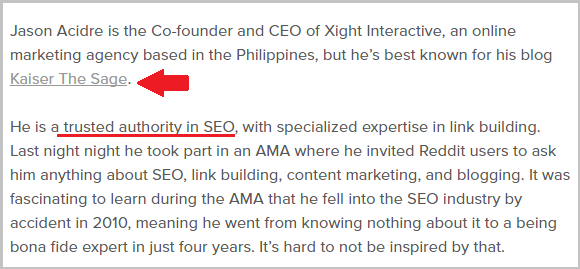
Google understands the relevance of a link without having to use exact match anchor texts all the time. Adding co-occurrences to linking pages can help search engines fully identify the context theme of your website with its linking web pages.
5. Find New Organic Ranking Keywords
When a linkable asset has been ranking for several long-tail keywords, finding untapped match keywords your content isn’t primarily catering to would be strategic.
You tend to rank these keywords (or had some impressions on SERPs) because search engines have highly perceived your content as worthy to rank for pages 3 or so.. (may not be visible on the first two SERPs pages).
The advantage when monitoring new keywords is that you can upgrade your content to cater to new audiences or be more desirable to rank for newly found organic ranking keywords by adding some topical sections to your piece.
What’s the implication of this to your anchor text link strategy?
If you’ve added a new section in your content piece to service those new organic keywords, it’d be additional anchor texts to use for internal and external manual link building. This will add more trust and authority to your content and help it dominate searches for those newly found organic keywords.
6. Search For Related Phrases and Instagram Trends
There is no such activity of finding new ranking keywords to add to your current list of target anchor texts, as you don’t want to use them all for exact match link strategy.
However, when trying to manually add descriptive anchor texts to internal linking pages and build linking pages (i.e. guest posts), you have to know what keyphrases are thematically relevant to your target keyword. Thus, it’d be easy for you to write robust content with LSI keywords and strategically do co-occurrences on links.
Two simple ways to find related search phrases of your target keywords.
First, do a straight Google search for the exact keyword or key phrase you’re trying to rank for. You can try two different searches. One is with quotes. The second is without. See at the bottom of search pages related search phrases Google provides based on the keyword you entered.
Second, just type in your keyword and wait for Google to suggest more specific/relevant search phrases. You’ll find out that some of them aren’t included in your keyword list from Google Keyword Planner or other common keyword research tools you use. They don’t need always to have a high search volume to decide whether or not they are good to target for content pieces.
If you ask me, where is this going? The answer is adding more keyphrases for your anchor text link strategy to be used for LSI keywords for internal and external content assets and to be better at co-occurrences on backlinks.
7. Optimize Content Using Content Gap Monitoring
I’ve been discussing how to find new organic keywords ranking in your content because these are useful for upgrading your content to its next version (or to 10x content if it hasn’t been achieved yet).
While you can simply focus on your content’s search results performance alone, you’d want to try seeing new organic keywords of similar content pieces your competitors normally produce.
The only difference between this process, which I’d like to label as “Content Gap Monitoring” with the typical “content gap analysis,” is that you’re doing it regularly – as part of your monthly SEO or content marketing activity.
SEO agencies that want to test this process out don’t have to worry about the time it’ll consume to run the entire process, as it is scalable through the use of Ahrefs as our primary content gap monitoring tool.
The first step is to find similar competing content. Only choose content assets that are specifically ranked for your target keyword. If you’ve done a robust competitor keyword research analysis as your first SEO initiative, you can skip this part already.
The second step is to monitor new organic keywords competing for similar content assets. Go to Ahrefs, then click on Alerts – New Keywords.
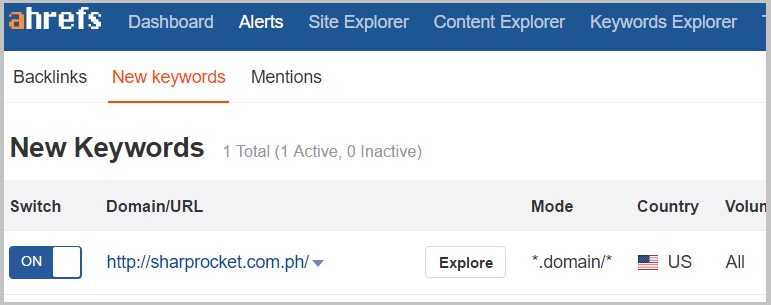
Click add alert button in the right section.

Choose URL as its mode, so you’ll only receive a list of new organic keywords that a specific page has been acquiring, not the whole domain. For volume, the default, “All” is good, so you can also see low-volume keywords.
For email frequency, it’s your decision whether to receive those organic keyword-centric emails weekly or monthly, but I highly recommend you go with weekly to upgrade your existing content for potential ranking keywords as sooner as possible.
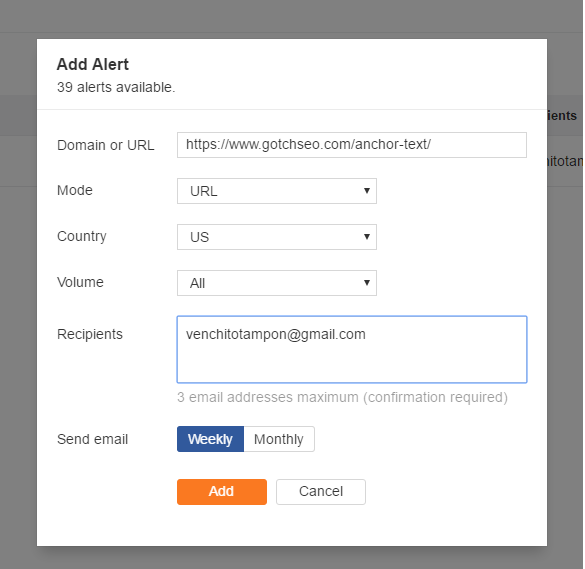
8. Backlink Audit on Exact Match Anchor Texts Links
With the recent Google Penguin update (most SEOs believe that it is indeed real-time), our activity to continuously monitor our site’s incoming links and make sure there aren’t any negative SEO isn’t any more a tedious task for us (SEOs/link builders).
If you have read posts on Google Penguin’s specific effects on SEO activities, there’s no need to make serious efforts to remove existing bad/toxic links to your website, as Google tends to devalue them anyway. So if a site has been receiving new low-quality links from a Negative SEO attack, for example, the efforts now shouldn’t be focused on removing those types of links but on continuously acquiring new high-quality backlinks for your site (this posts of mine on how to get backlinks and actionable link building strategies will help you a lot).
What’s the implication of this to my anchor text diversification?
In cases where those incoming toxic links are on exact match anchor texts, you don’t have to focus on removing them from your backlink profile but on driving new high-quality backlinks to your site. Since websites are dealt with granularly, those bad links won’t affect your site as a whole, only on parts that should be affected.
Nonetheless, a link audit is still a must. Google states that bad links are simply being devalued. The possibility of needing to disavow more links is unlikely. However, if you have a lot of unnatural links and never disavowed them, you need to disavow them. It may be why you’re still not recovering from the penalty.
You still have to do some groundwork for disavowing bad links. But keep in mind that while doing it, the focus shouldn’t just be there but more on helping your site continuously acquire good links to boost your site’s health over time.
If it’s real-time, your site can easily recover (some have proven this to happen to some fully/partially-recovered sites), and there’s much more work now to be put into higher-level link acquisition.
9. Convert High-Quality Exact Match Anchor Texss To Branded Links
Other posts on link audit (which I highly suggest need to be updated) discuss managing exact anchor text links by converting them into branded links.
In my experience, filtering your exact match anchor texts based on their quality should be everyone’s link builders/SEOs’ first initiative.
Don’t spend time converting low-quality exact match anchor texts to branded links, as these will be devalued (if it’s a negative SEO attack) or if they’ve been built by your past SEOs (do a link audit and link removal/link disavow).
What you have to focus on now is checking on only existing high-quality exact-match anchor text links. These links shouldn’t just be any type, i.e. directory or any massive link type, but only editorial links that are manually built, i.e. guest blog posts.
Whether or not these high-quality exact-match links are affecting parts of your website, you should still be converting them into branded links (as possible as you can), by manually reaching out to web admins to whom you’ve contributed guest posts in the past. Ask them if they are capable of changing those exact matches to branded types of links. This should help some parts of your site not to be negatively affected by real-time Penguin.
Now It’s Your Turn…
How do you diversify your backlinks’ anchor texts?
Or maybe you have a question about implementing any of the insights in our above list?
Either way, leave a comment quickly below.
I’ll be more than happy to reply to comments and answer questions.
So if you have a question, insight, or new tactic, leave a comment right now.
Anchor Texts Frequently Asked Questions
What is anchor text vs keywords?
Anchor text and keywords are two important elements in SEO. Keywords refer to the words or phrases you want to rank for on your webpage, while anchor text is the clickable text in a hyperlink that leads to another page.
In other words, the anchor text provides context to the link and helps search engines understand what the linked page is about. Using descriptive and relevant keywords in your anchor text is crucial to optimize your webpage’s ranking.
What is the content of anchor text?
The content of anchor text refers to the words that make up the clickable link. It gives users and search engines context about where the link will take them. Using relevant and descriptive anchor text is important to improve the user experience and help search engines understand the page content. Keep it brief, clear, and concise for maximum impact.
The Author
Venchito Tampon Jr
Venchito Tampon is a Filipino Motivational Speaker, Corporate Trainer, and a Leadership Speaker in the Philippines. He is the CEO and Co-Founder of SharpRocket, a link building agency. With a decade of experience, Venchito has a proven track record of leading hundreds of successful SEO (link builidng) campaigns across competitive industries like finance, B2B, legal, and SaaS. His expert advice as a link building expert has been featured in renowned publications such as Semrush, Ahrefs, Huffington Post and Forbes. He is also an international SEO spoken and has delivered talks in SEO Zraz, Asia Pacific Affiliate Summit in Singapore, and Search Marketing Summit in Sydney, Australia. Check out his other businesses, Hills & Valleys Cafe, Blend N Sips and Saas Pursuit.
How our LINK BUILDING AGENCY builds 250 links/mo consistently using Predictable Link Building Methodology™…
- Using a SIMPLE and PROVEN system
- Using a SCALABLE strategy
- No private blog networks
- No creepy outreach emails
